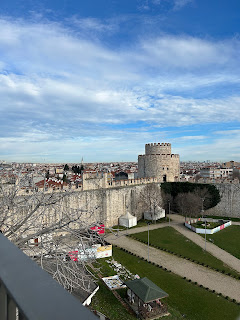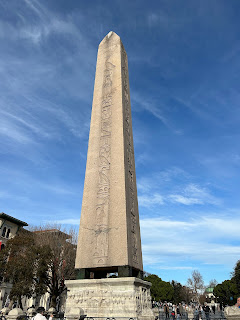On our first day in Istanbul, we met at 10:00am to visit our first spot of the course, the Theodosian Walls. The Theodosian Walls stretch all the way around the peninsula of Istanbul, which protected the city from attacks from the sea. Additionally, from a bit further south of the Yedikule Fortress to the Golden Horn, the Theodosian Walls prevented potential enemies from entering through land.
While we were unable to view every part of the walls, we did visit the Yedikule Fortress, which is an heirloom of Mehmed the Conqueror. The Yedikule Fortress is home to the Golden Gate, which was a gate used to welcome special guests, such as other emperors. The Yedikule walls consisted of 4 layers (walls, a moat, more walls, and the fortress), to slow down enemies as much as possible. Today, the fortress and the walls are being restored to its former glory while also being used as an event venue, for art, culture, and even weddings!
At the top of this fortress, we discussed other ways that people might defend a city. One such way is through religion. For example, when a siege on the walls occurred, many people claim to have seen Virgin Mary herself grab the invaders by their hair and toss them away from the walls, protecting its citizens and allowing Constantinople to live another day. Before leaving for Turkey, we discussed Thomas Tweed’s definition of religion and how religion can be used to cross boundaries. After learning how religion is able to defend a city, it suggests how religion can also be used to create physical boundaries between people.
After exploring the Yedikule Fortress, our bus drove us along the line of walls while heading back to our hotel. While the majority of the walls were not in the best condition, there are many restoration projects being done to the walls to restore them to their former glory. It’s interesting to see how different the old stones are from the newer stones and how erosion can greatly affect a wall that many invaders had trouble destroying. Whether it be through water or wind, it shows how powerful nature is overtime.
Speaking of water, one tactic that was used often when trying to conquer a city was to surround the city on all sides and wait for the city to surrender by cutting off their food and water supply. In cities such as Rome, the only way for them to get fresh water was to create aqueducts that ran all the way from Bulgaria which was approximately 150 miles away from Rome. This meant that if someone wanted to invade Rome, one way they could weaken them was by poisoning their water supply.
Even though Istanbul had walls to protect their city from immediate attacks, the city still needed something to sustain them if their food or water supply were to ever be cut off. Underneath their city, the people of Constantinople built a water supply that could supply its citizens with water for up to a year if their water supply were to ever be cut off. This place is called the Basilica Cisterns and was built in 537 around the same time the Hagia Sophia was built.
Due to its immense size and pillars, the Basilica Cistern also goes by the Sunken Palace, however, due to the inconsistency of the types of pillars used, we discussed how it was unlikely that this place was a palace. The inconsistency of the types of pillars used suggests the latin word, spolia, or stones that are taken from old structures and are repurposed in new construction or decorations. Spolia can be seen in many different parts of Istanbul which suggests that Istanbul takes pride in their historical architecture and history. This word reminded me of my COR class that I took in my fall semester and how cities might repurpose old buildings or areas to better suit the changing environment. It also makes me wonder how other cities might also preserve their history.
Another part of the Basilica Cistern that I found interesting were the Medusa heads at the bottom of two pillars. We discussed the purpose of these heads and why they were put here. Some people believe that they were used as an example for the length and width the pillars had to be to support the underground place, while others believe that it was used as a symbol for the end of pagan religions. I like to believe that it was used as a way to protect the Basilica Cistern and ensure that the water isn’t tainted.
The Hippodrome was our final destination on our first day in Turkey. While the Hippodrome still exists in Istanbul, the majority of it is left underground, and its location has turned into a public area.
Hippodrome gets its name from the Greek word Hippo, or horse, and the Greek word Dromos, or tribute/race. This provides a self-explanatory explanation for what the Hippodrome was mainly used for in the past, horse and chariot races and celebrations. The Hippodrome is approximately 400 meters on both sides. That’s twice the size of a regular outdoor track!
The Hippodrome also houses structures from other countries. For example, a fountain from Germany, a bronze structure from Apollo’s temple in Delphi, Greece, and a stone obelisk from Rome. My favorite structure present at the Hippodrome was the Obelisk sent by Egypt. I found this one most interesting due to the hieroglyphics on it and due to how pristine and clear it looked despite being 36,000 years old.














No comments:
Post a Comment